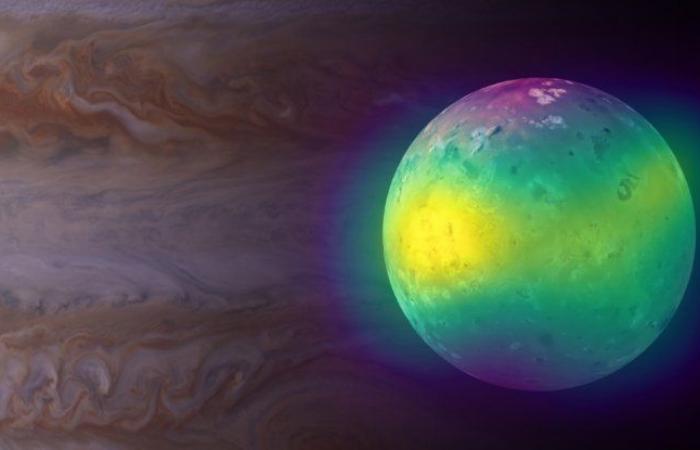New radio images of the Jupiter moon have finally provided some answers to longstanding questions about its atmosphere.
Io is the most volcanic place in the solar system. More than 400 active volcanoes stain its surface, a manifestation of the internal stress of the moon, which is pulled in different directions not only by Jupiter but also by the planet’s other three Galilean moons.
The thin atmosphere and surface of Io is dominated by sulfur dioxide – yes, sulfur – belching from within. It spits out as gas through volcanic crevices and throats and settles on the ground at night when it cools, giving the moon its sickly yellow and orange hues.
But how much of this gas is coming directly from volcanoes, compared to how much of frozen sulfur dioxide that has been reheated in sunlight? That was difficult to quantify.
“It was not known what process was driving the dynamics in Io’s atmosphere,” said Imke de Pater, astronomer of the University of California at Berkeley.
“Is it volcanic activity or gas sublimating from the icy surface when Io is in sunlight? We show that volcanoes actually have a major impact on the atmosphere. ”
The researchers finally have some answers and at the same time were able to detect plumes of volcanic sulfur dioxide on the moon.
For a world where volcanic gas is constantly leaking, Io’s atmosphere is surprisingly thin. Most of the gas it contains escapes through a complex interaction with Jupiter and its magnetic field at a rate of about 1 ton per second, contributing to a colossal plasma donut known as the Io plasma torus that orbits Jupiter.
The atmosphere that remains can reveal a lot about the geological processes inside the moon, which in turn could help us understand some of the dynamics of planets beyond our solar system.
When we fully understand the effects of competing gravitational influences on Io and why those influences don’t have the same effects on other bodies, we can draw more informed conclusions about how gravitational influences affect exoplanets too far away to see well.
So, astronomers used the Atacama Large Millimeter / Submillimeter Array (ALMA) in Chile to take a closer look at Io under radio wavelengths as it moves in and out of Jupiter’s shadow – a Jupiter solar eclipse.
The first thing they found is that sulfur dioxide doesn’t stay in IO’s atmosphere. At night the temperature drops below the freezing point of sulfur dioxide.
When this surface returns to daylight, the frozen sulfur dioxide sublimes back into the atmosphere and replenishes in about 10 minutes – much faster than expected.
This strange quirk turned out to be the perfect tool to study the contribution of the volcanic atmosphere.
“When Io moves into Jupiter’s shadow and has no direct sunlight, it is too cold for sulfur dioxide gas and condenses on IO’s surface,” said astronomer Statia Luszcz-Cook of Columbia University.
“During this time we can only see sulfur dioxide from volcanic sources. We can therefore see exactly how much the atmosphere is influenced by volcanic activity. ”
In the ALMA images, the team was able to clearly identify signs of sulfur dioxide and sulfur monoxide plumes from volcanic sources for the first time.
In volcanic regions with no sulfur dioxide or monoxide, they saw something else – potassium chloride, another volcanic gas.
This suggests that different volcanoes are opening up different magma reservoirs instead of dividing them. This suggests an interesting complexity beneath the surface of Io.
True color image of Io captured by the Galileo spaceship. (NASA / JPL / University of Arizona)
From their images, the team was able to calculate the volcanic contribution to the atmosphere of Io. Around 30 to 50 percent of sulfur dioxide comes directly from volcanoes.
Obviously, future work will help narrow this down. The team says the next step in their research is to measure the temperature of Io’s atmosphere, especially at low altitudes. This gets a little more difficult, but not impossible.
“To measure the temperature of Io’s atmosphere, we need to get higher resolution in our observations, which requires us to observe the moon over a longer period of time. We can only do this when Io is in the sunlight, as there is not much time spent in the dark, “said de Pater.
“During such an observation, Io rotates ten degrees. We need to use software that will help us create unbleached images. We previously did this with radio images of Jupiter that were created with ALMA and the Very Large Array. ”
The research is available in two articles, one of which was published in Das Planetary Science Journal, and the other in the press Das Planetary Science Journal and uploaded to arXiv.
These were the details of the news For the first time, astronomers see clouds of sulfur dioxide from... for this day. We hope that we have succeeded by giving you the full details and information. To follow all our news, you can subscribe to the alerts system or to one of our different systems to provide you with all that is new.
It is also worth noting that the original news has been published and is available at de24.news and the editorial team at AlKhaleej Today has confirmed it and it has been modified, and it may have been completely transferred or quoted from it and you can read and follow this news from its main source.

